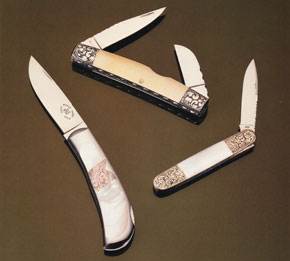Folding Knives
Simple pivoting clasp knives have been known since the days of the ancient Romans; today, makers and collectors alike appreciate the uncompromising challenge of creating a sculpture with working parts: the custom folding knife.
Like a fine watch or a sports car, the folding knife has dozens of parts that must work together and fit together, but not become loose.
Open a folder and look down the back. The handle material, liner, spring and blade should fit so closely that the back should seem like one piece, with no spaces between the materials. All the springs must be hand-made and tempered without warping and carefully fitted into the recesses of the handle. The locking action should be gentle enough for easy release, but firm enough to hold the blade safely. The blade should be perfectly centered, and the interior of the handle, where the blade fits, should be lined and nicely finished.
But most of all, the knife must meet the criteria of all custom-made knives. It should be straight from end to end, with fine-scale symmetry: each side should be an exact mirror image of the other. The bevels on the blade should be ground smoothly, without ripples or distortion. There should be no tool marks nor grind lines in the mirror finish.
Can you close your eyes, run a finger over the handle, spacers, and butt, and not feel the joints? That's a custom knife. No excess epoxy, glue or solder visible at the joints-some custom knives are so expertly fitted that no solder is used.
Check the uniformity of the bevels, the straightness of the edge, the flatness of the flats, the overall fit and finish of the assembly and polish. Brass or silver wrappings are a sign of extra care: they prevent perspiration rust on the exposed edges of the tang.
Everyone who appreciates textures loves the natural feel of materials like wood and horn and shell. The most durable material for knife handles today is Micarta, which is linen or wood soaked in a phenolic resin. It's virtually indestructible, but many custom makers prefer to make their handles of traditional or exotic materials: wooly mammoth ivory and bone, tusk of walrus and tooth of whale and hippo, horn of impala, woods with complicated patterns and delicate shades, like cocobolo, desert ironwood, and Brazilian rosewood.
A good scrimshaw scene can increase the value of a knife by several hundred dollars, and metal engraving or etching can cost well over a hundred dollars a square inch. Some makers decorate their own blades themselves, but more and more this is becoming specialized work as the reputations of scrimshanders and engravers grow.
|
 |
TOP: A D'Holder folder of 440-C mirror polished steel in the
"Congress" pattern: a bowed back with two blades with full file work on blades and spring.
The four bolsters are nickle-silver; the handle is whale's tooth, and the engraving is by
Mel Wood.
LEFT: A Hoel lockback folder with blade and spring made of 154-CM,, Long-wearing steel
The blade is flat ground with file work on the spine anc spring. The frames are nickel-silver with
three-piece abalone and mother-of-pearl inlays on each side.
RIGHT: Arkansas knifesmith Jimmy Lile made this folder out of D-2 steel with a satin
finish-a further step after mirror finishing. The front and rear bolsters are 14 karat gold,
the handle is mother of pearl. Lile did the file work on blade and spring, but James Stewart
did the engraving.
|
|
|